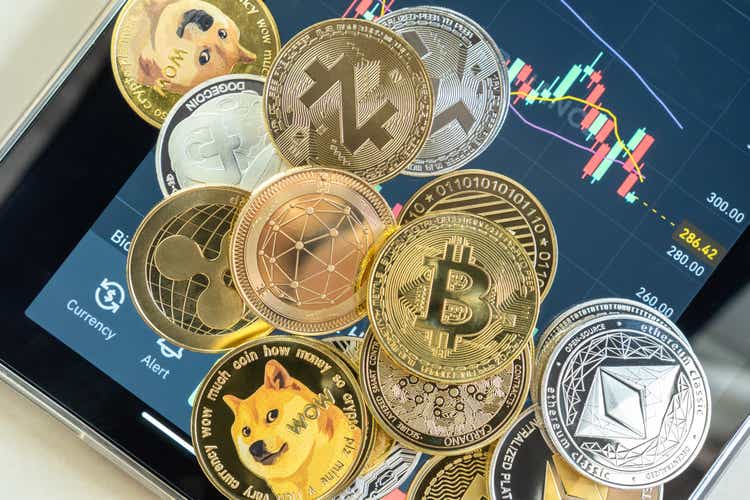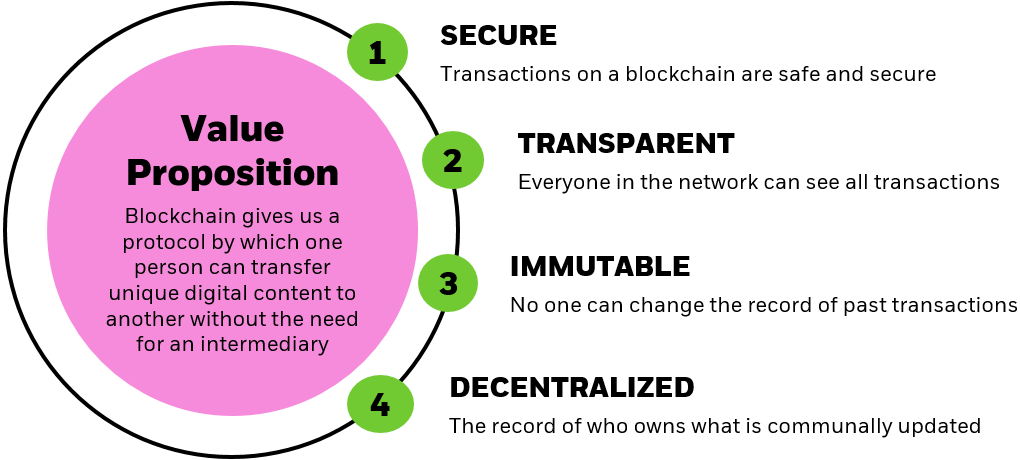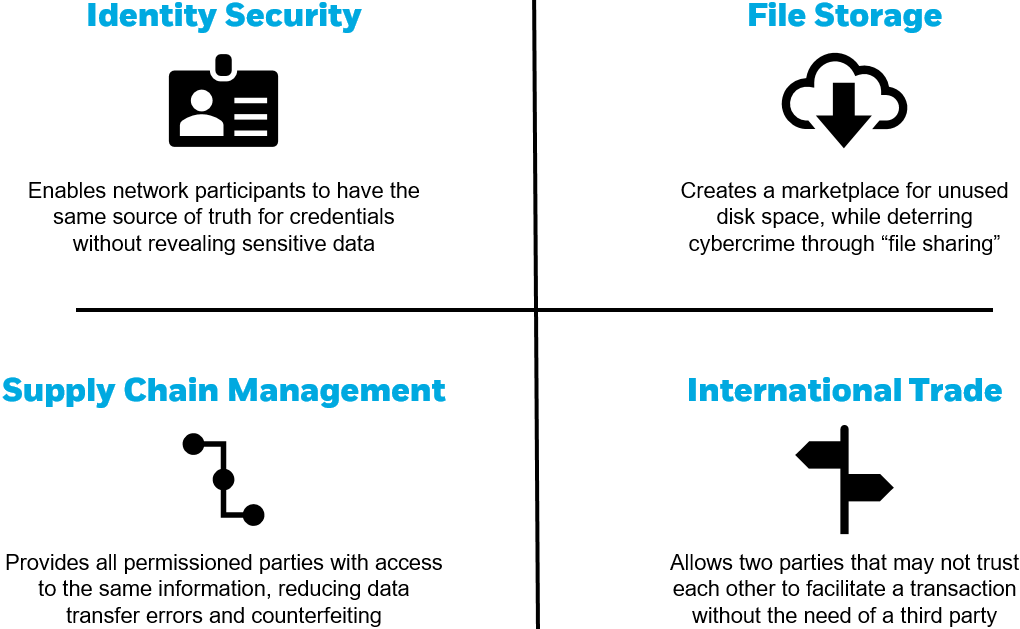
Chinnapong
Chinnapong
By Jeff Spiegel
Advances in blockchain technology are accelerating the burgeoning decentralized digital economy, revolutionizing the way industries operate – from financial services to supply chains and logistics. In 2021, worldwide spending on blockchain technologies reached US$6.6 billion, a figure that is expected to more than triple by 2024.1 These technologies have the potential to drive global economic growth: for example, PwC estimates that blockchain technology could boost world GDP by US$1.7 trillion by 2030.2
A blockchain is a decentralized and often public ledger that tracks the ownership of data or assets and enables the peer-to-peer transfer of that content without the need for an intermediary. The core innovation of blockchain technology is that it provides for the fidelity and security of a record of data and generates trusted transactions without the need for a third party.
In essence, a blockchain is a time-stamped, unchangeable record of who owns what digital content – and how much – at any given point in time. This record is not owned or controlled by any single entity: it is shared and communally updated by a network of computers or individuals referred to as nodes. It is called a blockchain because new transactions added to the ledger are parceled in ‘blocks,’ which are cryptographically linked, creating a ‘blockchain’.
A decentralized and unchangeable record of who owns what at any given point in time

For illustrative use only. For educational purposes only.
Chart description: Graphic showing what blockchain is and how it works. It states the value proposition of blockchain, namely that blockchain gives us a protocol by which one can transfer unique digital property to another without the need for an intermediary. The graphic also shows four key attributes of the blockchain value proposition: secure, transparent, immutable and decentralized.
Some blockchains are single-purpose and only facilitate the transfer of native cryptoassets – like Bitcoin – while others can facilitate transfer of their own native cryptoasset and other tokenized assets.
Blockchains also have an inherent security proposition. The record of past transactions on a blockchain is transparent and effectively unchangeable, preventing digital content from being replicated or tampered with. This network-level security differs from individual-level security considerations, whereby safeguarding one’s private keys to securely maintain control over blockchain-based assets presents unique challenges.
Multiple features make using blockchain compelling for various applications:
Put simply, using blockchains allows people to transfer value instantly from anywhere around the world, eliminating the need for intermediaries, in a low-cost and safe way. This has the potential to revolutionize virtually every industry in which data or property changes hands and can give rise to greater financial inclusion.
Since digital transactions are critical to nearly every function of today’s global economy, blockchain technologies have an unlimited range of potential uses, from improving the depth and efficiency of financial markets to serving as a foundation on which virtual worlds are built.
Below are examples of various use cases outside of finance and fin-tech

For illustrative use only. For educational purposes only.
Chart description: Graphic illustrating examples of various use-cases for blockchain in other industries beyond digital assets, including identity security, file storage, supply chain management, and international trade.
Today’s financial markets are generally managed by centralized systems and governing bodies, wherein consumers are reliant on intermediaries such as brokers, exchanges, and banks for transactions like trading securities or obtaining loans. The proliferation of blockchain transactions has given way to the term ‘decentralized finance’ or ‘DeFi’ — used to describe a subset of blockchain applications that replicate existing financial functions (e.g., exchange trading, borrowing/lending, derivatives, insurance, asset management) on a decentralized, peer-to-peer basis, governed by immutable code rather than intermediaries. This has the potential to usher in greater efficiencies that could ultimately extend financial inclusion to some of the 1.7 billion unbanked people around the world.3
These open-source applications allow users to directly interact with others on the underlying blockchain and can be accessed by anyone, through a mobile application or internet browser, anywhere in the world. Their functionalities can be wide ranging, from enabling simple transactions, such as exchanging and lending tokens, to more complicated transactions, like structuring investment contracts.
Blockchain technologies present ‘leapfrogging’ opportunities for emerging economies, especially where financial services infrastructure is less robust. With limited pre-existing infrastructure, the upside to adopting blockchain technologies in emerging markets is particularly high. Examples of this are already playing out across the world, allowing people to transact only using their phones and eliminating the need for certain elements of traditional banking practices, in ways that can reduce fees and eliminate barriers to access.
Smart contracts are central to many blockchain ecosystems. These contracts are conditional-based programs that are implemented by a blockchain and run when predetermined conditions are met. When those conditions are met, the contract is executed immediately – no paperwork or error reconciliation is required.
Smart contracts have a wide array of potential uses, from banking and financial services to gaming. One of the unique features of smart contracts is that they can be binding in much the same way as traditional contracts. Smart contracting could save the investment banking, retail banking and insurance industries anywhere from US$26 to US$39 billion annually.4
Smart contracts can also disrupt the insurance industry by enabling providers to pay out reimbursements when predefined conditions have been satisfied, providing significant automation to a historically manual process. In the personal motor insurance industry alone, cost savings could be up to US$21 billion via efficiencies in automation and reduced processing overheads in claims handling.5 This could lead to lower premiums where insurers pass on cost savings to consumers.6
With supply chains still inhibited, blockchain applications can help address the complexities of a US$18 trillion global trade market,7 enabling faster and more cost-efficient delivery of products, traceability, and coordination across a complex set of counterparties. This has powerful implications for tracking inputs and outputs, logistics, shipping, and consumers’ ability to trust the authenticity of the goods they purchase.
Today, there are more than 500,000 shipping companies in the U.S. alone. Blockchain in the logistics industry can make logistics processes leaner and more automated, potentially saving the industry billions of dollars per year. From the moment the shipment leaves the facility, to the time it arrives at its destination, a blockchain-enabled logistics ecosystem can safely document every move – reducing theft, ensuring quality, and automating payments.
Blockchain technologies are enabling the rise of a multitude of digital assets. A few examples include:
Digital Assets: An umbrella term that refers to cryptoassets, stablecoins, financial assets, and other tokens issued on a blockchain.
Cryptoassets: Cryptoassets are digitally ‘native’ assets, issued on a blockchain, that are intrinsic to the functionality of the blockchain itself (think Ether for the Ethereum Blockchain or bitcoin for the Bitcoin Blockchain). Blockchain protocols regulate the generation of new cryptoasset units and are used to incentivize the verification of transactions and secure the records of ownership without reliance on an intermediary, such as a bank or transfer agent.
Did you know? Adoption of cryptoassets globally today is outpacing the world’s adoption of the internet in 1999.8
Tokenized assets: A token is an ownership claim on an asset — an asset that can be fungible or non-fungible, tangible or intangible — that is issued, tracked, transferred, and verified on a blockchain. Tokenizing assets have a variety of potential benefits depending on asset class — they can be transferred in real time, settled without intermediaries, accessed on a globally interoperable basis, and programmed to capture attributes in an automated way. Tokenized financial assets are still early along the adoption curve, meaning no traditional asset classes have yet reached the point of being predominantly issued and traded in tokenized format.
Did you know? 3% of the world’s foreign exchange assets are already being tokenized and early progress has even begun in real assets, one of the largest global markets by value.9
Non-Fungible Token (“NFTs”): A subset of tokens that refer to the issuance of an ownership claim against a specific, identifiable asset, rather than a quantity of a broadly traded asset. Typically used for digital art and collectibles today.
Did you know? In December 2021, the most expensive NFT to date was sold for US$91.8 million. The NFT market peaked at US$41 billion in 2021, nearing the size of the conventional art market, at US$50 billion.10
Stablecoins: Stablecoins are a subset of tokenized financial assets in which the value of the token attempts to typically peg to a unit of value, such as the U.S. Dollar. Stablecoins seek to combine the technological innovations supported by cryptoassets with the pricing of traditional fiat currencies. Stablecoins are being explored by major financial institutions, central banks, and startups alike for their ability to enable the transfer of value in real-time at low cost. Stablecoins are primarily used today for cryptoasset trading and decentralized financial service protocols. At the frontier, they are being explored as an alternative for card payments, wires, certain transfers, and other types of payments that can settle via stablecoin in a digital wallet, as opposed to via traditional banking rails.
Did you know? The global market capitalization of stablecoins surpassed US$150 billion this year.11
Blockchain technology uses range from transactions and payment services to exchanges, as well as identity and security providers. Since these technologies are still relatively nascent, their multi-industry applications and value propositions offer high growth potential. The equity markets provide a range of ways to access this rapidly growing space across:
Miners: companies involved in verifying and adding cryptoassets to a blockchain
Exchanges: companies that run trading platforms, custodian wallets, and/or payment gateways
Hardware: companies that manufacture infrastructure or hardware used in blockchain activities (e.g. specialized semiconductors)
Users: companies that use blockchain technologies to enhance new or existing products (e.g. decentralized finance)
Investors seeking to holistically capture the blockchain opportunity could consider blockchain ETFs that are diversified across the many companies who could stand to benefit from an increase in the adoption of blockchain technologies, such as miners, exchanges, hardware companies and a wide range of users.
——
© 2022 BlackRock, Inc. All rights reserved.
1 Statista, ‘Worldwide spending on blockchain solutions from 2017 to 2024,’ 5/23/2022.
2 PWC, ‘Blockchain technologies could boost the global economy US$1.76 trillion by 2030 through raising levels of tracking, tracing and trust,’ 11/13/2020.
3 The World Bank, ‘The Global Findex Database 2021: Financial Inclusion, Digital Payments, and Resilience in the Age of COVID-19,’ 2021.
4 Capgemini Consulting, ‘Smart Contracts in Financial Services: Getting from Hype to Reality,’ 2016.
5 Carnomaly, ‘Three Ways Blockchain is Revolutionizing Auto Insurance.’
6 Capgemini Consulting, ‘Smart Contracts in Financial Services: Getting from Hype to Reality,’ 2016.
7 Deloitte, ‘Using blockchain to drive supply chain transparency,’ 2017.
8 Statista.com, Crypto.com, IDC, NUA Ltd., Internet World Stats, ourworldindata.org.
9 EY, ‘Tokenization – From illiquid to liquid real estate ownership,’ 2/15/2022.
10 Insider, ‘NFTs ballooned to a $41 billion market in 2021 and are catching up to the total size of the global fine art market,’ 1/6/2022.
11 Reuters, ‘Explainer: What are stablecoins, the asset rocking the cryptocurrency market?’ 5/12/2022.
Carefully consider the Funds’ investment objectives, risk factors, and charges and expenses before investing. This and other information can be found in the Funds’ prospectuses or, if available, the summary prospectuses, which may be obtained by visiting the iShares Fund and BlackRock Fund prospectus pages. Read the prospectus carefully before investing.
Investing involves risk, including possible loss of principal.
Index performance is for illustrative purposes only. Index performance does not reflect any management fees, transaction costs or expenses. Indexes are unmanaged and one cannot invest directly in an index. Past performance does not guarantee future results.
Companies that are involved in the development, innovation, and utilization of blockchain and crypto technologies are subject to a number of risks: the technology is new and many of its uses may be untested; intense competition; slow adoption rates and the potential for product obsolescence; volatility and limited liquidity; loss or destruction of keys to access accounts or the blockchain; reliance on the internet; cybersecurity risks; and the lack of regulation and the potential for new laws and regulation that may be difficult to predict. In addition, blockchain companies involved in cryptocurrencies may be adversely affected by fluctuations in, and manipulation of, the price of cryptocurrencies. Moreover, the extent to which companies utilize blockchain technology may vary, and it is possible that even widespread adoption of blockchain technology may not result in a material increase in the value of such companies.
International investing involves risks, including risks related to foreign currency, limited liquidity, less government regulation and the possibility of substantial volatility due to adverse political, economic or other developments. These risks often are heightened for investments in emerging/ developing markets or in concentrations of single countries.
Funds that concentrate investments in specific industries, sectors, markets or asset classes may underperform or be more volatile than other industries, sectors, markets or asset classes and than the general securities market.
Technologies perceived to displace older technologies or create new markets may not in fact do so. Companies that initially develop a novel technology may not be able to capitalize on the technology.
There can be no assurance that an active trading market for shares of an ETF will develop or be maintained.
This material represents an assessment of the market environment as of the date indicated; is subject to change; and is not intended to be a forecast of future events or a guarantee of future results. This information should not be relied upon by the reader as research or investment advice regarding the funds or any issuer or security in particular.
The strategies discussed are strictly for illustrative and educational purposes and are not a recommendation, offer or solicitation to buy or sell any securities or to adopt any investment strategy. There is no guarantee that any strategies discussed will be effective.
The information presented does not take into consideration commissions, tax implications, or other transactions costs, which may significantly affect the economic consequences of a given strategy or investment decision.
This material contains general information only and does not take into account an individual’s financial circumstances. This information should not be relied upon as a primary basis for an investment decision. Rather, an assessment should be made as to whether the information is appropriate in individual circumstances and consideration should be given to talking to a financial professional before making an investment decision.
The information provided is not intended to be tax advice. Investors should be urged to consult their tax professionals or financial professionals for more information regarding their specific tax situations.
The Funds are distributed by BlackRock Investments, LLC (together with its affiliates, “BlackRock”).
The iShares Funds are not sponsored, endorsed, issued, sold or promoted by Bloomberg, BlackRock Index Services, LLC, Cohen & Steers, European Public Real Estate Association (“EPRA®”), FTSE International Limited (“FTSE”), ICE Data Indices, LLC, NSE Indices Ltd, JPMorgan, JPX Group, London Stock Exchange Group (“LSEG”), MSCI Inc., Markit Indices Limited, Morningstar, Inc., Nasdaq, Inc., National Association of Real Estate Investment Trusts (“NAREIT”), Nikkei, Inc., Russell or S&P Dow Jones Indices LLC or STOXX Ltd. None of these companies make any representation regarding the advisability of investing in the Funds. With the exception of BlackRock Index Services, LLC, which is an affiliate, BlackRock Investments, LLC is not affiliated with the companies listed above.
Neither FTSE, LSEG, nor NAREIT makes any warranty regarding the FTSE Nareit Equity REITS Index, FTSE Nareit All Residential Capped Index or FTSE Nareit All Mortgage Capped Index. Neither FTSE, EPRA, LSEG, nor NAREIT makes any warranty regarding the FTSE EPRA Nareit Developed ex-U.S. Index or FTSE EPRA Nareit Global REITs Index. “FTSE®” is a trademark of London Stock Exchange Group companies and is used by FTSE under license.
© 2022 BlackRock, Inc. All rights reserved. BLACKROCK, BLACKROCK SOLUTIONS, BUILD ON BLACKROCK, ALADDIN, iSHARES, iBONDS, FACTORSELECT, iTHINKING, iSHARES CONNECT, FUND FRENZY, LIFEPATH, SO WHAT DO I DO WITH MY MONEY, INVESTING FOR A NEW WORLD, BUILT FOR THESE TIMES, the iShares Core Graphic, CoRI and the CoRI logo are trademarks of BlackRock, Inc., or its subsidiaries in the United States and elsewhere. All other marks are the property of their respective owners.
iCRMH1022U/S-2350303
This post originally appeared on the iShares Market Insights.
Editor’s Note: The summary bullets for this article were chosen by Seeking Alpha editors.
This article was written by